Prayer Plant Propagation
Prayer Plant, Circadian Rhythm (Night)
At one point in time, many of us have been intrigued by the idea that, in fact, plants are always in motion. The Maranta leuconeura is a native plant to South America, originally, Brazil. These tropical plants prefer a warm humid environment and grow up to 6-12 inches. As the daylight fades, the prayer plant slowly closes its leaves together, creating circadian rhythms, like hands closed in a prayer, earning its amicable name. According to my research, there are 31 genera and 535 species within the Marantaceae family. It is known for the arrowroot family to have benefiting aspects. By that I mean, some of them are edible. All distributed throughout warm temperate and tropical regions of the world.
Prayer Plants (Maranta Leuconeura) is one of the Marantaceae, also known as, arrowroot family of plants that my group and I will be investigating. They thrive in humidity, but with too much direct sunlight, the leaves will scorch. Which can quickly kill the plant. This is why they are primarily grown indoors because of their tolerance for low light levels. When watering the plant, room temperature is best. This is a good way to keep the plant happy and during the winter, always reduce watering the plant, just as the days are shorter and our nights are generally more cool and moist. Aside, from the beauty of this plants and its magical movements. They are edible and the roots are actually a good source for starch.
Economically, It is known that Marantaceae is an important source of food. Maranta arundinacea L. from tropical America is also cultivated in tropical regions of the West Indies and Africa. Countries, including, Brazil, India, Sri Lanka, Indonesia, China, Kenya, Rwanda and Tanzania have been reported to grow arrowroot (Kay et al., 1987; Munguti et al., 2012; Abun, 2005). It is an industrial plant from which arrowroot starch is produced from the rhizomes of plants grown in the West Indies and Antilles (Scaramuzzi and Apollonio 1997). Kumar and Parrack (2003) showed the feasibility of using arrowroot starch as a low-cost substrate.
One of the most dramatic features of the world in which we live is the cycle of day and night. In correspondence to Circadian Rhythms, this is a process in which a subset of biological rhythms with periods defined as a time to complete one cycle. In plants, leaf movement rhythm was one of many rhythms that included germination, growth, stomatal movement and gas exchange, photosynthetic activity, flower opening, and the beauty of it all, fragrance emission. Rhythmic movements in plants were to be caused by the daily cycles of light and dark. This cycle occurs because of the plant’s metabolism, physiology, and behavior of organisms’ changes between day and night is obvious to even the most casual observer.

Point Map of Maranta Leuconeura
References :
- “Phylogeny and Biogeography of the Prayer Plant Family: Getting to the Root Problem in Marantaceae.” Academia.edu. Web. 12 May 2016.
Hpercival12. “Introduction to Circadian Rhythms in Plants.” YouTube. YouTube, 2013. Web. 12 May 2016. - Heuzé V., Tran G., 2015. Arrowroot (Maranta arundinacea). Feedipedia, a programme by INRA, CIRAD, AFZ and FAO.http://www.feedipedia.org/node/545 Last updated on October 26, 2015, 17:04
- In Vitro Propagation of Arrowroot (Maranta Arundinacea L.). GlobalScienceBooks, 2009. Web.
- Maranta arundinacea L. (n.d.). Retrieved May 23, 2016, from http://plantillustrations.org/illustration.php?id_illustration=190524


